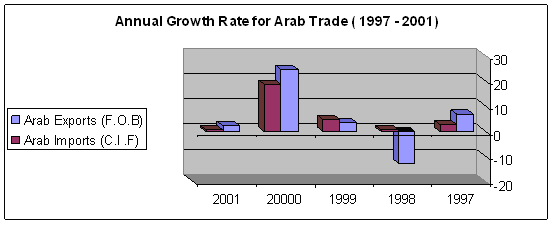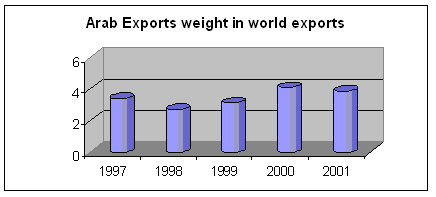|
 |
|
|
|
|
| |
|
|
Introduction |
|
“Within the Arab world, all
countries except Sudan, Syria and
Somalia, are net importers of
agricultural products. The average
net import of agriculture products
per individual is considerably
higher in the GCC countries and
Libya than other Arab countries,
with the exception of Lebanon. Given
the relatively low income per
capita, the Arab countries that are
likely to be hurt most by the rise
in agricultural prices are Lebanon,
Jordan and Djibouti.
The low average net import of
agriculture products per individual
in most of the other Arab countries
might have positive implications for
the Arab region. It will reduce the
likely impact of the expected rise
in prices of agricultural products
on increasing poverty in the region,
since most of the large net
importers of agricultural products
are the countries with relatively
high income per capita.
On the other hand, the prices of the
manufactured products, will likely
be reduced due to trade
liberalization. All the Arab
countries are major importers of
manufactured products. Given the
likely increase in the prices of
agricultural products and the likely
fall in the prices of the
manufactured goods, the net effect
on the cost of living of the
population in the Arab region is not
entirely clear. For the poor, it is
more likely that their cost of
living will be increased, because of
the high share spent on food in
their budget. However, the
percentage rise in their cost of
living is expected to be less than
the rise in the prices of
agricultural products, because part
of the increase in the prices of
food will be compensated for by the
fall in the prices of basic
manufactured products” (Abed El-Khalek,G.
and Karima Korayem, 2003)
“Moreover as most of the labor force
in Arab countries are agricultural
workers the impact of trade
liberalization on growth and
employment creation in the Arab
countries (and most of the
developing countries) will be less
than in the case of developed
economies that are mainly
manufacturing-producers” .(El
Khawaga, L., 2000) |
|
|
| |
Arab Foreign Trade (1997 – 2001 ) |
| |
|
Value in
Billions $
|
Annual Growth
Rate (%)
|
Average Growth Rate (1996 – 2000) % |
1997
|
1998
|
1999
|
2000
|
2001
|
1997
|
1998
|
1999
|
2000
|
2001
|
|
Arab Exports
|
185.4 |
149.6 |
175 |
257 |
235.8 |
3.0 |
-19.3 |
17 |
46.9 |
-8.3 |
9.3 |
Arab Imports
|
147.5 |
154 |
145.3 |
155.5 |
162.9 |
2.6 |
4.4 |
-5.4 |
7.3 |
4.8 |
2 |
World Exports
|
5529 |
5441 |
5626.4 |
6330.5 |
6064 |
3.9 |
-1.6 |
3.4 |
15.5 |
-4.2 |
4.4 |
World Imports
|
5624.4 |
5545.3 |
5772.6 |
6500.6 |
6280.9 |
3.9 |
-1.4 |
4.1 |
12.6 |
-3.4 |
4.7 |
Arab Exports
weight in world exports
|
3.4 |
2.7 |
3.1 |
4.1 |
3.9 |
|
|
|
|
|
|
Arab imports
weight in world imports
|
2.6 |
2.8 |
2.5 |
2.4 |
2.6 |
|
|
|
|
|
|
|
|
|
| |
Value and Growth of the Intra Arab Trade (1997 –
2001 ) |
|
Value in
Billions $
|
Annual Growth
Rate (%)
|
1997
|
1998
|
1999
|
2000
|
2001
|
1997
|
1998
|
1999
|
2000
|
2001
|
Intra Arab
Trade
|
27.9 |
26 |
27.1 |
33.0 |
33.5 |
5.1 |
-6.8 |
4.2 |
21.8 |
1.5 |
Arab Exports
(F.O.B)
|
15.7 |
13.7 |
14.2 |
17.7 |
18.1 |
6.9 |
-12.7 |
3.6 |
24.6 |
2.3 |
Arab Imports
(C.I.F)
|
12.2 |
12.3 |
12.9 |
15.3 |
15.4 |
2.9 |
0.8 |
4.9 |
18.6 |
0.7 |
|
|
|
|
|
|
 |
|
|
|
|
|
 |
|
|
|
|
Total Exports of Arab Countries According To
S.I.T.C. (in millions of U.S. Dollars) |
Country
|
2000 |
1999 |
1998 |
1997 |
1996 |
1995 |
1994 |
1993 |
1992 |
1991 |
|
Jordan |
1,897.46 |
1,831.88 |
1,802.40 |
1,835.53 |
1,816.60 |
1,770.99 |
1,424.50 |
1,248.12 |
1,220.16 |
1,131.52 |
|
Emirates |
43,294.76 |
35,071.48 |
31,071.48 |
33,998.64 |
33,595.75 |
29,335.33 |
27,384.91 |
23,644 |
24,271.32 |
22,745.85 |
|
Bahrain |
5,700.53 |
4,140.43 |
3,270.21 |
4,383.51 |
4,699.73 |
4,112.77 |
3,616.76 |
3,723.40 |
3,464.36 |
3,513.03 |
|
Tunisia |
5,778.39 |
5,583.79 |
5,758.27 |
5,559.18 |
5,519.37 |
5,469.34 |
4,642.74 |
3,746.14 |
4,013.68 |
3,782.28 |
|
Algeria |
19,535.00 |
12,452.04 |
10,931.00 |
13,887.10 |
12,591.90 |
10,448.90 |
8,591.05 |
10,097.70 |
11,123.65 |
9,263.03 |
|
Saudi
Arabia |
77,584.25 |
50,756.74 |
38,821.90 |
60,732.44 |
60,728.44 |
50,040.85 |
42,614.15 |
42,395.19 |
50,287.05 |
47,696.66 |
|
Sudan |
1,807.00 |
780.09 |
596.26 |
594.18 |
620.23 |
555.67 |
523.89 |
417.27 |
319.26 |
305.00 |
|
Syria |
4,525.65 |
796.22 |
658.46 |
979.35 |
1,143.04 |
1,296.91 |
1,206.62 |
1,174.92 |
1,228.58 |
1,545.10 |
|
Somalia |
|
|
|
|
|
|
|
|
109.28 |
106.46 |
|
Iraq |
9,507.99 |
5,128.00 |
3,976.00 |
2,331.00 |
503.00 |
423.99 |
389.32 |
471.39 |
608.64 |
486.97 |
|
Oman |
11,318.60 |
7,237.97 |
5,508.45 |
7,656.70 |
7,373.21 |
6,065.02 |
5,542.26 |
5,365.41 |
5,555.27 |
4,871.26 |
|
Qatar |
11,593.96 |
7,213.74 |
5,030.49 |
3,855.99 |
3,832.99 |
3,557.01 |
3,146.37 |
3,245.41 |
3,840.71 |
3,209.81 |
|
Kuwait |
19,573.01 |
12,276.61 |
9,616.14 |
14,278.18 |
14,946.56 |
12,830.82 |
11,256.72 |
10,282.11 |
6,546.20 |
1,061.55 |
|
Lebanon |
714.44 |
676.87 |
661.80 |
643.04 |
1,020.01 |
825.97 |
572.13 |
451.10 |
573.20 |
547.00 |
|
Libya |
12,250.00 |
7,834.47 |
5,275.78 |
8,860.51 |
9,696.76 |
9,112.27 |
8,620.58 |
7,684.86 |
9,867.34 |
10,567.22 |
|
Egypt |
4,620.21 |
3,546.26 |
3,206.49 |
3,919.23 |
3,538.94 |
3,451.43 |
3,471.57 |
3,120.56 |
3,054.14 |
3,619.91 |
|
Morocco |
7,403.33 |
7,508.87 |
7,143.64 |
4,676.61 |
4,744.88 |
4,711.96 |
3,971.10 |
3,695.69 |
3,977.36 |
4,281.99 |
|
Mauritania |
426.00 |
370.00 |
369.00 |
413.00 |
485.00 |
493.00 |
435.80 |
417.80 |
449.80 |
515.17 |
|
Yemen |
4,079.68 |
2,439.87 |
1,497.50 |
2,503.99 |
1,964.50 |
794.34 |
203.03 |
185.45 |
199.77 |
347.41 |
|
Total |
241,610.25 |
165,645.32 |
135,195.26 |
171,108.19 |
168,820.92 |
145,296.56 |
127,613.50 |
121,367.31 |
130,709.76 |
119,597.23 |
|
|
|
|
|
More Resources |
|
► |
Bagherzadeh,
Morvarid and Raed Safadi (2003)
"Market
Access Issues for MENA Countries: Where
are the Obstacles?"
Newsletter of the Economic Research Forum,
Volume ten -Number three -Autumn 2003(Cairo
: ERF ) |
|
► |
Fatteh, Zaki
(2003)
"The Global Industrial Scene and the
MENA Region"
Paper presented in the 10th
Economic Research Forum Conference
December 2003 ( Cairo: ERF) |
|
► |
Haddad, Mona "Export
Competitiveness : Where does the Middle
East and North Africa Region stand?"
Economic and Social Commission for Western
Asia |
|
► |
Kheir- El-
Din, Hanaa & M. Maamoun,
Abdel-Fattah(2000)
"Textiles
and Clothing in the Mediterranean Region:
Opportunities and Challenges of Returning
Textiles and Clothing to GATT Disciplines"
(Cairo: Economic Research Forum) |
|
► |
United Nations Conference
on Trade and Development
(2003)
TRADE AND
DEVELOPMENT REPORT 2003
(Geneva :UNCTAD ) |
|
► |
Chaherli,
Nabil and Moataz El-Said (2000)
"Impact
of the WTO Agreement on MENA Agriculture"
(Cairo : Economic Research Forum ) |
|
► |
Al-Atrash, Hassan M. &Yousef,
Tarik (2000)
"Intra-Arab
Trade - Is It Too Little?"
(Washington D.C.:
International Monetary Fund) |
|
► |
جبر، فلاح سعيد(2001)
انعكاسات العولمة
وتحرير التجارة على الصناعة العربية
(القاهرة:
جامعة الدول العربية, المنظمة العربية
للتنمية الإدارية) |
|
|
|
|
|
|